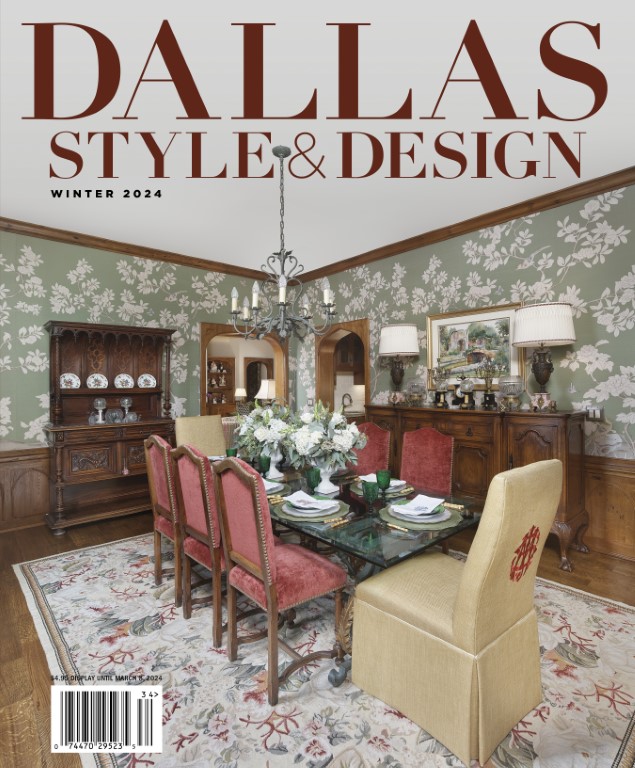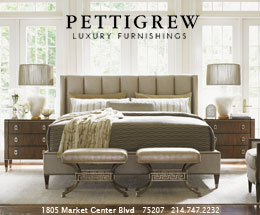
Meticulously decorated, the dining room features carved antique French chairs with Aubusson tapestry upholstery, antique French terra-cotta cherubs, an 18th Century French chest and a portrait of the homeowner by Anthony Will.

The color scheme of shades of butter and beige with a vibrant layering of rich jewel tones carries into the kitchen sitting room. Here, the portrait, Man on Horse by S.E. Waller (1899), sits proudly above the fireplace. The room also features bronze andirons with lions and a French bronze clock with elephant.
For many interior designers, the first clients are often the most memorable. Special friendships form, and some can last a lifetime. Such was most certainly the case for designer Michael Fannin, owner of Michael P. Fannin Interior Design, when he met and began working with a prominent Dallas couple more than 40 years ago.The husband – a lawyer and avid golfer – and his wife – a mother and quiet collector who loved a good patty melt – were among the very first of Fannin’s treasured clients, and they eventually became good friends as they collaborated over the years on various homes and projects. But by far, one of the most noteworthy homes he helped this couple design and furnish is a stately dwelling built more than 15 years ago, poised amidst the elegant gated community of Place des Vosges. An exclusive neighborhood that sits at the edge of Highland Park on Turtle Creek Boulevard, this quiet little sanctuary tucked within the city of Dallas was designed to mirror the picturesque Place des Vosges located in the Marais District in Paris, at the junction of the 3rd and 4th arrondissements. The oldest planned square in the City of Light, the scenic setting has been cherished for centuries for its Louis XIII-style architecture and satisfying symmetrical facades.
“The style of all the homes in the Dallas community of Place des Vosges are faced in limestone, and the rooflines are set from the top of the property to the bottom,” says Fannin. “This means that the homes at the deepest part of the development have the highest elevation and the most volume. It took a bit over two years from groundbreaking before these homeowners were able to move in, and their decision to build here was made in part to accommodate pieces from both of their families in this blended home. The couple had amassed an extensive collection of exquisite old pieces that needed a home to do them justice.”
Conveniently close to all the leisure pursuits enjoyed by the couple, this posh urban retreat is just minutes from a pristine golf course and country club, the city’s spectacular museums and symphony, the Dallas Arboretum, and numerous shops and restaurants. The classic architecture of the home was mainly dictated by the covenants of the development yet allowed a considerable margin for personal interpretation. Custom finishes and surfaces – Venetian plaster with gold-leaf accents, sleek marble and granite,
rustic limestone, and lustrous peach-and-black pecan flooring – were chosen to contribute to the couple’s sense of elegance and to highlight their amazing collection of old world
antiques and stunning works of art. By working patiently and intimately with them – essentially living life with them – Fannin created a warm and inviting home that truly
reflected the personalities of these very special clients.

The media room features Richard Iams’ Grand Canyon and Fritz Scholder’s Indian Forever paintings,
and a bronze sculpture of nesting loons.

The family room houses an 18th-century gilt mirror over the limestone fireplace, an English floor clock
with chinoiserie, porcelain parrot lamps with ormolu mounts, Aubusson tapestry-covered
benches and a tortoiseshell tea caddy.
“Our goal in designing this home was to make a fairly large structure feel both intimate and comfortable,” says the designer. “I did most of the space planning and detailing for this house with the homeowners’ complete participation. My belief is that we all have a basic instinct for colors, styles and ambience that make us comfortable. My job is to help define that, sometimes by deletion and at other times by addition. My primary goal in this process is that comfort and ease are paramount. I help make homes—not houses— more beautiful.”
Working with his masterful signature palette—warm and soothing color over soft, serene neutrals—Fannin created a subdued backdrop in shades of butter and beige and brought each room to life with a vibrant layering of rich jewel tones.

In the library, an antique Country French writing desk is surrounded by an Imari collection in the
shelves. A pair of Yale Burge carved French armchairs are upholstered in Old World Weavers
grospoint.

Custom finishes and surfaces – Venetian plaster with gold-leaf accents, sleek marble and granite, rustic
limestone, and lustrous peach-and-black pecan flooring – were chosen to contribute to the couple’s
sense of elegance and to highlight their collections of old-world antiques and stunning works of art.
The homeowners also wanted Fannin to help them combine their amazing collection of antique furniture pieces – some from her family, some from his. Many are Country French or English Country in style, with age, patina and incredible presence. Drawn to the character rather than the value of these exceptional pieces, the couple amassed an impressive cache that includes a handcrafted English-style dining table accented with Louis XV dining chairs covered in Aubusson tapestry, an elegantly ornate secretary in the formal living room embellished with beautiful hand-carved accents, a rustic French armoire by the family room fireplace, and an antique French desk with a stunningly rich patina and inlay accents in the library. Fannin added some new upholstered seating to the mix, but what he enjoyed most was marrying the his-and-her pieces to make an eclectic and warmly inviting home.
“Finding just the right fabrics, trim and wallpapers was the icing on the cake,” notes Fannin. “The final additions—artwork, lamps, surface decorations and other tchotchkes— always take the most time but are truly what liven and personalize the space. It’s in these small objects—collected, curated and loved—that personal expression is most notable. The trust given to me by these clients throughout the entire process is ultimately what I valued most, but more importantly, it was creating a refuge, a home to which they could retreat.”
Jeanne de Lathouder currently resides in Kansas City, where she works as a freelance writer for books and publications across the country. Contact her at jdelathouder@gmail.com.












